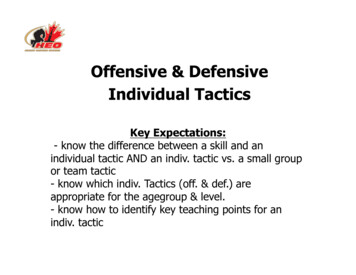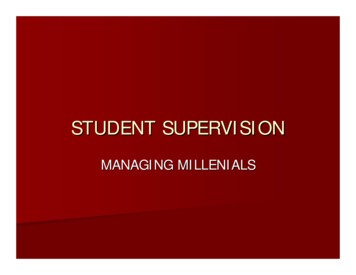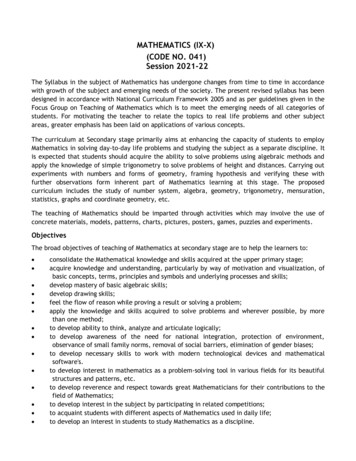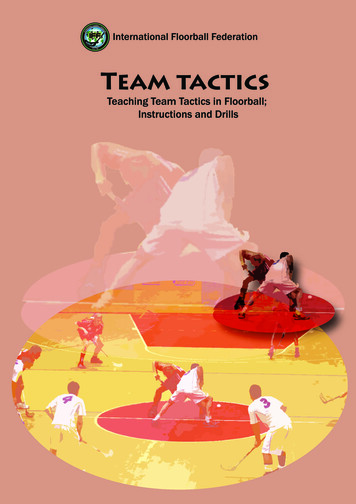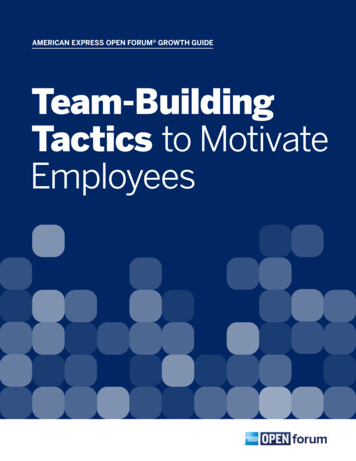
Transcription
American Express OPEN Forum Growth GuideTeam-BuildingTactics to MotivateEmployees
Table of Contents45 Team-Building Exercises toHelp Your Employees BondBy Anita Campbell7Could Your Team Survive an‘Escape Room’?By Katie Morell116 Things to Consider WhenPlanning a Business RetreatBy Mike Michalowicz14What It Takes to Create aLeadership CultureBy Jane Hiscock17When All the World’s a Stage,Build an EnsembleBy Amy Cortese21Build Teamwork Into YourVirtual Team248 Strategies for Big (or Small)Organizational ChangesBy Barry Moltz27By David NiuWhat’s the Glue That HoldsYour Team Members Together?By Sarah RobinsonA version of this content was originally published on openforum.com. American Express OPEN Forum helps small-business owners find the insights, inspiration andconnections to help grow their businesses. Learn more at openforum.com.The information contained in this guide is for generalized informational and educational purposes only and is not designed to substitute for, or replace, a professionalopinion about any particular business or situation or judgment about the risks or appropriateness of any approach for any specific business or situation. THIS GUIDEIS NOT A SUBSTITUTE FOR PROFESSIONAL BUSINESS ADVICE. The views and opinions expressed in authored guides on OPEN Forum represent the opinion ofthe author and do not necessarily represent the views, opinions and/or judgments of American Express Company or any of its affiliates, subsidiaries or divisions(including, without limitation, American Express OPEN). American Express makes no representation as to, and is not responsible for, the accuracy, timeliness,completeness or reliability of any opinion, advice or statement made in this guide. 2017 American Express Company. All rights reserved.Team-Building Tactics to Motivate Employees2
IntroductionEvery business owner is also the coach of a fast-movingteam. A key component for success is cultivating talent,managing personalities and bringing out the best in everyemployee.Easier said than done. Amid the day-to-day hustle andbustle of running a business, it can be challenging to see thebigger picture—and connect the dots between members ofyour team and how they work together. In this guide, ourexperts highlight tips and tactics to foster an environmentwhere people are happy, motivated and well-equipped todo their best each day—whether they’re walking throughthe front door of the office or signing on virtually.Want to bring your team closer? Try listening exercises ora scavenger hunt. How can you build a leadership culture?Open the floor to new voices. Think you’re ready for acompany-wide retreat? Believe it or not, the food and drinkyou serve can be just as important as the agenda.ISTOCKHiring right is essential, but it’s just the start. How youmanage and guide your team along the way can positionyour company for real growth—and make showing up towork a whole lot more fun.By Rod KurtzRod Kurtz is Editor-at-Large of OPEN Forum and a New York-based media strategist.Editor-at-large, OPEN ForumFor more than a decade, Kurtz served as a journalist and advocate on behalf ofentrepreneurs—before becoming one himself. Today, he works with a variety of brandsand organizations, on all things content and storytelling. His work has appeared inpublications including The New York Times and CNNMoney, and he appears as a regularguest on TV and radio, including CNN, MSNBC and the Today show. He is also a guestlecturer in entrepreneurship at The Wharton School at the University of Pennsylvania.Team-Building Tactics to Motivate Employees3
ONA DesignsTRACY FOSTERMEMBER SINCE 075 Team-Building Exercises to HelpYour Employees BondLooking to re-energize your employees? These simple team-building exercisescan help workers learn more about each other and work together to achieve yourcompany’s goals.By Anita CampbellFounder and CEO, Small Business TrendsA business may only succeed if its team is able toHere are five team-building exercises you can use to helpwork as a cohesive unit. Sure, everyone has their ownstrengthen your team.strengths and responsibilities. But they still need to beable to weave those strengths together effectively toachieve a company’s main objectives.1 Active listeningActive listening can embody a number of differentThat’s where team building comes in.activities. One of the most common and effectiveactive-listening exercises involves physically showingThere are several different team-building exercises andwhoever you’re communicating with that you’re actuallyactivities you can use to build cooperation, trust andlistening. So instead of quietly sitting still while theybonds among your team. Plus, they can be really fun!talk, you could nod, smile or show another form ofTeam-Building Tactics to Motivate Employees4
ISTOCKacknowledgement. Try this exercise—after listening to afull meeting or similar event where your whole team ispresentation or discussion, have your team summarize,present and can be broken off into teams of two.in their own words, what was said.To play, choose two team members and have themThis team-building exercise can help encourage yourstand in a large circle with a line down the center,employees to really hear one another and improvewith one standing on each side of the line. Tell themcommunication throughout your workplace. Whentheir goal is to get the other person to cross over thesome might feel they’re not being heard or othersline using any means other than physically draggingmight get distracted during regular communication,them across. They can bargain, persuade or eventhis method can really help encourage people to beginbribe.listening and communicating clearly.After the game is completed, have your entire team2 Crossing the linediscuss what happened during the game. One ofthe benefits of this game is demonstrating to yourThe main part of this team-building exercise is playedemployees the best ways to persuade and influencewith just two people. But the real value can come frompeople positively. For instance, it’s often morethe discussion afterward. So consider doing this at aeffective to ask the other person what they wantTeam-Building Tactics to Motivate Employees5
rather than just making demands or offering themsplit up teams so everyone has to work with people insomething that’s really of no interest to them.other departments, if your goal is to encourage interdepartmental cooperation.It can also show your employees the value of communityThe benefit of this exercise can be to get your teamover straight competition.to work together to create a healthy, competitiveatmosphere. You can either use the scavenger hunt to3 Find the common threadimprove teamwork among people who work togetherThe goal of this team-building exercise is to have yourevery day, or to get people who don’t work together toteam members find some of the things they haveform bonds and improve communication.in common. To play, break your team up into smallgroups and instruct each group to find one thing theyIf you use company-centric clues, it can also helpall have in common. They might find that they all haveincrease their knowledge about your business indogs, love Motown music or regularly watch the samegeneral.TV show. When each group has found at least onecommonality, bring them all back together and havethem announce what they discovered about eachother.5 Truth and a lieThe purpose of this game, sometimes called “twotruths and a lie,” is to help your team to get to knowOnce completed, you should have a team that knows aone another better. To play, have each member of yourbit more about their fellow employees. Some will nowteam come up with three statements to share aboutrealize they share common bonds. Some might eventhemselves. Two of those statements should be true,realize that the preconceived notions or assumptionsand one should be a lie. When each person shares theirthey had made about their fellow co-workers werethree statements, have the rest of your team discussincorrect.which one they think is the lie.By playing, you can encourage more open communication4 Scavenger huntthroughout your team, because everyone will know justScavenger hunts can be popular activities for parties anda bit more about who they work with. Some might evenvarious other gatherings. But they can also be effectivebe surprised to find out some things they never knewas team-building exercises. To put a business spin onabout each other. And that can help improve the workingthis activity, split up your team by department, then setrelationship your team members have with one anotherup clues related to your company. Alternatively, you canoverall.ABOUT THE AUTHORAnita Campbell is the founder and CEO of Small Business Trends, a website andAnita Campbellmagazine providing news, insights and resources to 2 million small-business owners andentrepreneurs each month.Team-Building Tactics to Motivate Employees6
ISTOCKCould Your Team Survivean ‘Escape Room’?Victor Blake’s Escape the Room experience—where groups arechallenged to solve puzzles to escape a locked room—is rewritingthe book on team-building exercises.By Katie MorellIndependent JournalistTake a moment to imagine yourself walking into a churchDa Vinci Code” where participants are tasked withand hearing a door lock behind you. Your heart startssolving a puzzle for how to get out of a locked roomto pound and you realize you’ll do anything to get out.within 60 minutes. (Note: There is an emergency buttonYou aren’t sure how, so you walk over to the churchyou can push at any time to get out.) Escape the Roomconfessional, open the door and BAM!—you are staringis one of a handful of businesses in the new “escapedown a pathway to a secret cave. Now assume that youroom” space where individuals, families and co-workersaren’t alone, but surrounded by co-workers, and youpurchase tickets to get locked in a room together for anmust work together to reach the ultimate goal: Freedom.hour and have to solve a unique puzzle of how to get out.Welcome to Escape the Room’s Dig room—a mixture“Remember in Raiders of the Lost Ark when Indianaof, as the company puts it, “Indiana Jones and TheJones had to find an amulet and staff and have the sunTeam-Building Tactics to Motivate Employees7
shine through it to open the door to the cave?” asksforth from my house to the rented space in the backVictor Blake, Escape the Room’s founder. “It’s just likeof a cab while keeping my full-time job. I didn’t thinkthat. You don’t have a map or instructions; you have tothis would become a new business; I thought it wouldwork together to figure it out.”be just a fun way to make some extra cash.”Blake somewhat stumbled on the company idea. A NewBut become a business it did, and by March 2014,York-based longtime puzzle lover, he was traveling quiteBlake had quit his job, opened up a permanenta bit as part of his finance job and downloading puzzlelocation in Manhattan and created several more gamegames on his phone. He thought a real-life versionrooms. Since then, his business has exploded; he’swould be fun to try, so on a whim in October 2013, heopening a new location approximately every otherrented a 300-square-foot space inside another office,month in cities such as Atlanta; St. Louis; Detroit;created his own game with props and shared the newsMinneapolis, Minnesota and Scottsdale, Arizona.via word of mouth through friends.And, while at first Blake was thrilled to welcomeindividuals, couples and families into his locations, the“I didn’t have a website, but we sold out by the secondword quickly spread to companies looking for team-weekend,” he says. “I started moving stuff back andbuilding activities.ISTOCKTeam-Building Tactics to Motivate Employees8
“I did not anticipate the corporate team-building thingbecause I didn’t even know that that was a market,” hesays. “Now, it is a huge part of our business.”I recently spoke with Blake about how escape rooms canhelp teams bond.Why are escape rooms so popular right now?There are several reasons for this. First, it issomething that every person can do. It isn’t scaryor stressful; it is fun. I also think adults are lookingfor another activity outside of eating and drinking.Brunch isn’t an activity. Going to an escape room is.People come here, have a great time and then go toa bar. Their experience here becomes the dominantconversation at the bar.But beyond that, I find that we are a great place forintergenerational families to connect. Everyone getsISTOCKto participate and no one is using a screen, phone,computer, etc. The connection it provides speaks to alot of people.Why do you think Escape the Room iseffective for team-building purposes?What makes a team succeed or fail at anEscape the Room experience?Our success rate across all of our games is only about20 percent, and it all comes down to how the teamworks together in the room. You might think that aA lot of companies have corporate hierarchies wheregroup of, say, engineers would do well, but many times Iyou always know where you fit. Experiences likefind that they all think similarly, which isn’t necessarily aEscape the Room flip that on its head, and I thinkgood thing in these scenarios. Teams that come in withthat is refreshing to a lot of people. We will havea diversity of thought are the ones that break records.everything from startups coming in with their interns,HR managers bringing in teams that aren’t working wellThe teams that do the best are the ones that focus ontogether, and bosses and employees. You name it, aopen communication. You can’t be the guy in the roomvariety of groups come in. We’ve gotten so popular thatthat finds the clue and doesn’t tell anyone about it.several companies have us as a preferred vendor, whichYou can’t do it alone. The teams that win are the onesmeans they can even do team building with their clientsthat listen to each other, regardless of hierarchy at theat one of our locations.office.Team-Building Tactics to Motivate Employees9
The ones that don’t win have members who are afraidI think it’s important to know that team building doesn’tto speak up in front of the big boss. An employee mayonly need to be among internal employees. Considerworry that he or she has an idea but that it is a stupiddoing these types of things with your suppliers, vendorsone, so they stay silent. Chances are, though, whateverand clients—the results can be tremendous.they are thinking isn’t stupid at all, and it would helpthe team if they said something. On the other hand, ifa boss says he or she has the answer and doesn’t wantWhat kind of feedback do you get from yourcorporate clients?to listen to constructive feedback, the team won’t win,either.I get a decent amount of emails saying that comingto Escape the Room was the best thing a person’sHow often do you think companies shouldschedule team-building activities?company has ever done. I think the biggest complimentI ever get is when someone plays with co-workers andhas such a great time that they bring their friends andDepending on your corporate goals, as often asfamily. That happens a lot.possible, really. We have a ton of repeat corporatecustomers who come in every few months. And wehave so many different rooms that they can play adifferent puzzle each time.What advice can you offer about how acompany can maximize their team-buildingexperience?For any type of team building, I think it is most“I think it is most importantto be open to the organicfluidity of the experience.Just because you are theboss at the office, doesn’tmean you should be theboss while team building.”—Victor Blake, founder, Escape the Roomimportant to be open to the organic fluidity of theexperience. Just because you are the boss at theoffice, doesn’t mean you should be the boss whileteam building. Be open to letting people shine indifferent ways. Listen and communicate. Throw awayyour preconceived notions of how a person is becauseusually those notions are just wrong.And get into it. There can be a general sense ofcynicism about team building, but I recommend youreally throw yourself into the experience. You willquickly realize just how much you can get out of it.ABOUT THE AUTHORKatie Morell is a San Francisco-based journalist who specializes in business/Katie Morellentrepreneurship, social justice, travel, health and science topics. Her work has appearedin Bloomberg Businessweek, Fast Company, San Francisco, Hemispheres, BBC Travel, USAToday, mental floss and others. For more information, visit www.katiemorell.com.Team-Building Tactics to Motivate Employees10
ISTOCK6 Things to Consider WhenPlanning a Business RetreatA well-planned business retreat may help you bring your teamcloser together while addressing issues that may be affectingyour company’s growth.By Mike MichalowiczSerial Entrepreneur, Author and SpeakerOne of the businesses I owned did forensic computermassive waste of time and money. These six suggestionswork. It was a crazy, stressful industry, with forensicmay help you make the next company retreat you plan atechs everywhere in the field and frantic requests forsuccessful one.lab analysis. We had a great team, but the dynamics ofmany strong personalities—coupled with the rapid-firepace we had to keep—meant that working together was1 Plan the event outside the office.sometimes difficult. We were the poster company forWe’re creatures of habit, and trying to establishneeding a business retreat.new dynamics in the same old scene may lower thelikelihood of success. Disrupting the company’sBusiness retreats may be able to pull your team togetherordinary routine may help usher in new ways of workinginto a cohesive, productive force, or they might be atogether. You may want to avoid any distractions duringTeam-Building Tactics to Motivate Employees11
your retreat—consider picking someplace where yourour company’s weaknesses and hypothesizing ways toteam can relax and learn new ways of communicatingimprove it was super enlightening. We also navigatedand collaborating.an orienteering course. It got people off their feet andoutdoors. While it didn’t seem like it was business-based,2 Identify the people attending.If you’re unable to shut your business down for thethe skills we learned helped us grow closer as a team.Whether you’re creating imaginary companies or trying tofollow a map using a compass, plan carefully.retreat, you may want to leave some folks behind to keepthe company running. We opted for an annual retreatwhere some key people attended every year, and others4rotated their attendance.Make sure food and drink is handledwell.Folks need to eat—especially if you want them physically3 Have a clear agenda in advance.and mentally active! I wouldn’t advise leaving the foodand drink arrangements as an afterthought. FeedWhen putting your business retreat together, consideryour team properly and consider using meals as anplanning activities with two main goals in mind: gettingopportunity to grow closer.your team to learn and share together, and also gettingthem to let their hair down.5“Think about dolingout accolades wherewarranted, and makingsure you send your teamhome with a sense ofpride.”— Mike Michalowicz,serial entrepreneur, author and speakerHave a clear opening and closingprocess.When you begin your business retreat, consider coveringyour goals and expectations with your team. And whenyou wrap up, you may want to reflect on what you’veaccomplished during the retreat. Think about doling outaccolades where warranted, and making sure you sendyour team home with a sense of pride.6Strive for a balance among allpeople.Some people are naturally more dominant than others.In order to facilitate sharing, learning and growing, itmay be helpful to find a way to put everyone on theI recommend having two distinct kinds of activities: thosesame level. A number of strategies may help to equalizethat are explicitly business-oriented and those that aren’t.your team. We used a speaking stick: The rule was thatOn one retreat, we did a business exercise called Utopiaevery member of the team must hold the stick andCorporation. Teams of two created an imaginary companyspeak with no interruptions for a specified time. It’sthat was better than the one we actually had. Identifyingalso important to structure competitive activities in aTeam-Building Tactics to Motivate Employees12
ISTOCKway that lets various people shine. Consider choosingproductive team. We managed stress better. Weactivities that privilege a range of skill sets so thatdelivered better results more quickly, and we did it alleveryone gets a chance to be the leader and look like awith enthusiasm, knowing that we could do more as arock star. Learning to celebrate the accomplishmentsteam than we ever could alone.of others is key.It got to the point where some employees lookedThe well-planned business retreat can function as aforward to the company retreat more than they didreward, a workout, a challenge and an invigoratingtheir own vacations. But that perfect retreat doesn’tperspective shift—all rolled into one. Our retreatsjust happen on its own. It’s the result of careful planningtransformed our scattered, frantic collection of talentedand creativity. Taking the time to put in work ahead ofindividuals into a cohesive, balanced and amazinglytime may pay massive dividends in the end.ABOUT THE AUTHORMike MichalowiczMike Michalowicz is the entrepreneur behind three multimillion-dollar companies and theauthor of Profit First, The Pumpkin Plan and The Toilet Paper Entrepreneur. Michalowicztravels the world as an entrepreneurial advocate and is globally recognized as the guy who“challenges outdated business beliefs” and teaches entrepreneurs what to do about it.Team-Building Tactics to Motivate Employees13
ISTOCKISTOCKWhat It Takes to Create aLeadership CultureBuilding a culture of strong leadership may be the best way tohappier, more fulfilled employees.By Jane HiscockPresident and CEO, Farland GroupAsk a group of business owners or employees fornight stomach” kicks in, bringing a sense of anxiety abouttheir definition of leadership and you’ll get a rangewhat the coming work week will bring. But fostering aof responses. But they’ll likely all boil down to a fewculture of strong leaders may help put employees at ease.principles: autonomy, collaboration, mentorship,Here are five ways to help put those positive principles inconsensus building, listening and a commitment to theaction and create a culture of leadership.customer experience.We all know what good leadership looks and feels like atwork. Turnover is low, productivity and profitability areUnderstand the need for strong leadersand strong managers.high and there’s a sense of pride among people acrossNot every good manager is a strong leader, but allthe company. Yet too many of us also know what badorganizations need both types of people. Critical toleadership looks and feels like, especially as “Sunday-cultivating an environment that embraces both strongTeam-Building Tactics to Motivate Employees14
leaders and strong managers is to avoid an “up-or-out”culture that’s built around aggressively climbing theBe open to different leadership styles.ladder. Not everyone is going to move up and that’s OK.This isn’t just about nurturing different approaches toStrong managers that embody a very good day-to-daygetting the job done. Sometimes it’s about shaking upacumen of supporting your business needs can be asthe dynamics completely. For example, consider theimportant as having leaders to shape the future.rise of “holacracy,” which eliminates titles and insteadorganizes teams into self-governing circles with explicitKnow when to seek collaboration andwhen to build consensus.responsibilities and expectations that are focused ongetting the work done. This, in theory, heightens thecommitment to improving the customer experience,The nuances between the two are subtle, yet canboosts loyalty by eliminating hierarchies and increaseshave a remarkable difference on a project’s outcome.productivity by giving a voice to everybody in theCollaborative styles are ideal for longer-term initiatives,organization.where decision making is spread across the companyto establish goals and policies for the organization,for example. Consensus building is most successfulTear down traditional corporate walls.when it’s employed by small, agile teams who build fastThere’s often a reluctance to let “outsiders” in to learnsolutions and prototypes to drive productivity. It’s also aabout your company and product direction—and forgreat way to pilot potential leaders as they learn to buildgood reason. But taking an all-or-nothing approachconsensus among smaller teams with less at stake.to including partners and customers as stakeholdersISTOCKTeam-Building Tactics to Motivate Employees15
can limit your organization. It can stunt your abilityto accelerate growth, gain valuable market insightand build trust. Instead, try creating circles of trustedadvisors, including customers and partners that canhelp shape your company’s direction and inform howto lead in your industry. Don’t forget, these so-calledoutsiders also have a stake in your future.“Shift the reward criteriaand watch how quicklymanagers become leaders,companies becomeinfluencers and customersbecome advocates.”—Jane Hiscock, president and CEO, Farland GroupNever compromise the customerexperienceISTOCKThere are few companies on the planet that wouldAll this talk about leadership might beg the questionadvise otherwise, but what does it really mean to “neverabout who follows if everybody’s leading. The realitycompromise the customer experience?” Put anotheris that the lines are now blurred as more voices areway, are your leaders equally rewarded for meetingencouraged to be heard. This doesn’t mean we’llquotas and shaving margins as they are for customernecessarily lose traditional corporate structures, evensatisfaction, retention and growth? Shift the rewardthough some might be completely upended. What itcriteria and watch how quickly managers becomedoes mean, however, is that it may be time for yourleaders, companies become influencers and customersorganization to rethink how it defines, values andbecome advocates.rewards leaders.ABOUT THE AUTHORJane HiscockJane Hiscock is president and CEO of Farland Group, a C-level customer-engagement andmarketing consultancy. Her role in helping companies develop stronger C-suite loyaltyprograms gives her firsthand exposure to the sharing and exchange of innovative ideas andperspectives of hundreds of C-level executives every year.Team-Building Tactics to Motivate Employees16
ISTOCKWhen All the World’s a Stage,Build an EnsembleCathy Salit’s consulting company, Performance of a Lifetime, uses thepower of improv to help teams connect with each other, solve problemsand work better together.By Amy CorteseJournalist and AuthorCathy Salit is an actor, performer and renegade who,might otherwise impede personal and organizationalat age 13, dropped out of school and started hergrowth. The signature exercise from which theown alternative school in a former dry cleaning shop.company takes its name asks people to create a one-It taught her that you can break rules and createminute performance of their lives. Naturally, the worksomething new. “I’ve been improvising ever since,” sheenvironment at New York-based POAL is anything butsays.business as usual. Meetings typically start with animprov exercise—and lots of applause.Today, her consulting company, Performance of aLifetime, or POAL, combines psychology, theaterI recently spoke with Salit about team building—or, asand education to help break down barriers thatshe prefers to call it, ensemble building.Team-Building Tactics to Motivate Employees17
How do you work with organizations onteam building?performances, like a salesperson giving a presentation.But we believe that we’re all in a play of our collectivemaking. And to better navigate and perform in that play,We work with companies on the execution of the humanwe need to tap into this natural ability to imagine, toside of their business—they’ve got some new initiatives,pretend and to play, so that we are both performers andand in order to support that, they’re going to have todirectors.develop and support their people. We have to not justchange behaviors, but have people grow in the waysthey need to grow. People now have to work togetherYour work centers on something you call the“Becoming Principle”. Tell us about that.who might hate each other, for example. That’s verycommon, or some version of that. They don’t get eachThe idea is that we’re not just who are; we’re who we areother’s worlds. And that’s a disabler.and who we are not, and if we are going to tap into ourhumanity, we need to get reconnected with that. ThinkIt’s about helping people cross boundaries. Ourabout what we do with babies: They’re these little cutepreferred way of talking about it is ensemble building,creatures that make these sounds, and us big peoplebecause we believe that all human beings are naturalsay in these little voices, “Ooh, you’re so cute, let meperformers. Sometimes we do things that we know areget you a cookie.” And that’s actually how babies learnISTOCKTeam-Building Tactics to Motivate Employees18
to speak. They’re not speakers, but we relate to themAfter 90 minutes, they came back and they had comeas if they are, and it is that conversation that gives themup with some wonderful solutions. It was by virtue ofthe platform, the stage to speak.the fact that they had both sides working on it that theywere able to come up with solutions that were relevantThere is a field that we’re inspired by, and hopefullyto each side. Afterwards, the inter-department problemsinspire, called performative psychology, led bydiminished. They no longer hung up the phone on eachLev Vygotsky. He talks about a “zone of prox
Team-Building Tactics to Motivate Employees 6 Anita Campbell ABOut the AuthOr Anita Campbell is the founder and CEO of Small Business Trends, a website and magazine providing news, insights and resources to 2 million small-business owners and entrepreneurs eac


